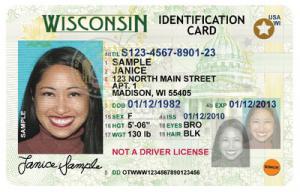Real IDSome 200,000 federal building to be affected by REAL ID as of 10 October
Beginning 10 October, security screeners in roughly 200,000 federal buildings may deny access to visitors who present a driver’s license or identification card from a state which is non-compliant with REAL ID rules. A passport or ID specially approved by the federal government may be used as proof of identity. The Government Services Administration (GSA) says there are 275,195 buildings which are owned and leased by the federal government as of 2014. Enforcement of the REAL ID Act has so far been limited to only 217 of these buildings.

Gold star in upper right corner indicates compliance // Source: wisconsindot.gov
Beginning 10 October, security screeners in roughly 200,000 federal buildings may deny access to visitors who present a driver’s license or identification card from a state which is non-compliant with REAL ID rules. Keeping IDentities Safe notes that a passport or ID specially approved by the federal government may be used as proof of identity.
The other day, DHS released guidance for federal agencies for this phase of REAL ID enforcement. The document is REAL ID Act of 2005 Implementation: An Interagency Security Committee Guide, and it contains a list of approved federal and state issued IDs.
The 2005 REAL ID Act prohibits federal agencies from accepting driver’s licenses and IDs which do not meet standards set by DHS. One purpose of the REAL ID Act was better to safeguard federal facilities from terrorist attacks. The guide explains how identity card clearances are to be uniformly applied to protect federal employees and private citizens who work in and visit these buildings.
The Government Services Administration (GSA) says there are 275,195 buildings which are owned and leased by the federal government as of 2014. Enforcement of the REAL ID Act has so far been limited to only 217 of these buildings. This next phase of enforcement will include “semi-restricted” federal facilities with Federal Security Levels 3, 4, or 5. Federal buildings where no ID checks currently occur, such as museums, benefits offices, and government hospitals will not be among those covered by the increased enforcement.
Brian Zimmer, president of Keeping IDentities Safe, said, “States or territories that are not REAL ID compliant or have not received an extension to by DHS to comply will be most impacted. Residents of New Hampshire, Minnesota, Louisiana, and New York, are already being denied access to a few hundred federal facilities. Of these, only in New York does the governor have the authority to direct the state DMV to comply. The other three states require legislative action to remove anti-REAL ID barriers. Adding as many 200,000 federal and military buildings with access restrictions will increase incentives for states to comply with REAL ID requirements. This REAL ID enforcement guide demonstrates that positive measures are being taken to protect federal employees and our soldiers on military bases from suicidal shooters and terrorists.”
